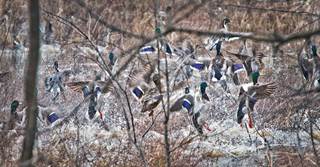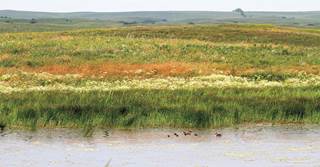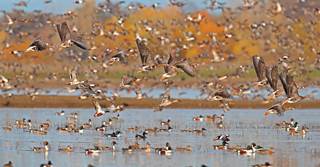Why the Mission Matters
By supporting DU's wetlands and waterfowl conservation efforts, we can all help make the world a better place
By supporting DU's wetlands and waterfowl conservation efforts, we can all help make the world a better place
By Scott C. Yaich, Ph.D.
By the time you receive this issue of Ducks Unlimited magazine, I will have just retired from DU after a 35-year career in conservation. I've been incredibly lucky to have spent my professional life working on behalf of wetlands and waterfowl habitat conservation, to which I remain deeply committed. Conservation matters greatly to me, as it does to all DU members. But why does it matter? How can an organization like DU so effectively bring us all together when we are so different? We come from places as worlds apart as New York City and Houma, Louisiana, from across political and religious spectrums, and from different generations. Yet, when we gather at DU events, our differences seem to dissipate and we find ourselves naturally bound together by what we sharea dedication to DU's conservation mission. It matters deeply to each of us.
A mission statement is "a formal summary of the aims and values of a company, organization, or individual," and DU's mission statement is Ducks Unlimited conserves, restores, and manages wetlands and associated habitats for North America's waterfowl. These habitats also benefit other wildlife and people. I'd wager that although few of us could recite that formal mission statement, the meaning behind those words speaks to our souls and of many things that make our lives worth living. DU's mission is so compelling and unifying because it matters to us all, in many different ways.
As DU's 80th anniversary arrived this January, it jarred me a bit to realize that I've had a personal connection with the organization for over half its existence. I first joined DU in 1975, and have been associated with it ever since. This 40-plus-year affiliation has allowed me to see and experience the ways that DU's mission matters from a variety of perspectives. Each issue of Ducks Unlimited magazine is full of stories about our conservation work, so I'll simply try to provide a broad overview of why the mission matters to me based on my personal experiences as a DU member, partner, volunteer, and finally staff scientist.

Photo TODDSTEELEPHOTOART.COM
Like many of us, I first joined DU because I was a waterfowl hunter. I didn't grow up in duck country, though, so I didn't begin to hunt ducks until October 1974, when I was in graduate school in southern Illinois. But when I waded before dawn into a flooded pin oak flat and heard the sound of thousands of ducks flushing off the water, mallard wings hitting tree branches, and wood ducks squealing, I was hooked before I ever fired my first shot. Several of my friends were already duck hunters and members of DU, so I soon attended my first event and became a member. Although I didn't know much about DU, I figured that because I was now a duck hunter I had a personal obligation to support the organization whose singleness of purpose was to conserve waterfowl habitat.
In 1974, DU's conservation efforts were focused on Canadian breeding habitats, and about 1.7 million acres had been conserved by the organization since 1937. It was important to me to know that the money I spent with DU was being used to conserve duck habitat, and reading about DU's work in this magazine made me feel good. Seeing ducks every hunting season felt even better, and provided a tangible connection to why the mission mattered to me.
After graduating and then working several years for Southern Illinois University creating wetlands on reclaimed mined lands, in 1985 I began the public service portion of my career with the Arkansas Game and Fish Commission (AGFC). I worked as the state's waterfowl and wetlands program coordinator, which gave me the opportunity to begin to see DU through the eyes of a partner. And living in a duck hunter's mecca wasn't bad either.
The mid-1980s was a pivotal time for waterfowl conservation. Populations slipped to a low point due to prolonged drought on the prairies, and hunting seasons were restrictive. This situation gave rise to the North American Waterfowl Management Plan, which was approved in 1986. The plan made clear that government alone could not restore waterfowl populations, and that the private sector must take on an important role in conserving habitat across North America to bring back the ducks.
DU had foreseen the necessity of a continental approach to waterfowl conservation, and the need for the private sector to step up its efforts to "give back." In 1984 the organization initiated its U.S. habitat program by opening the Great Plains Regional Office in the heart of the all-important Prairie Pothole Region. Shortly thereafter, DU launched its Matching Aid to Restore States' Habitat program, based on the recognition that in order to thrive, waterfowl also require healthy migration and wintering habitats. This program provided funding for delivering habitat projects with conservation agencies in all 50 states, and I was happy to have DU's increased level of partnership in conserving wetlands in my state of Arkansas.

Photo MICHAELFURTMAN.COM
In the 1970s, the declining status of wetlands and water in the United States became an important conservation issue, and by the late 1980s over 50 percent of the nation's historical wetlands were gone forever. Arkansas, the most important wintering area for North America's mallards, had lost more wetlands than any other noncoastal state. Because my top job priority was waterfowl and wetlands conservation, the importance of DU's mission was clear to me.
DU, the AGFC, and other state and federal conservation agencies share key constituencies, and hunters are foremost among them. The loss of millions of acres of waterfowl habitat has also left fewer places to hunt, so DU and partners like the AGFC consider how new wetland restoration projects will increase hunting opportunities. DU has completed conservation work on over 2.1 million acres of public lands across all 50 states. More than 91 percent of those acres are on wildlife management areas, national wildlife refuges, and other public lands open to hunting, and much of the other 9 percent is habitat explicitly designed to boost the quality of hunting in surrounding areas. So there can never be any doubt that DU's mission matters to all hunters who pursue waterfowl and the many other species of wildlife that share these habitats.
When I lived in rural eastern Arkansas, many of my friends and neighbors were rice farmers. Although their mission may have been rice production, it was easy to see how DU's mission mattered to them as well. Increasing numbers of rice farmers enrolled in DU programs and secured pipe and water-control structures that benefited their farming operations in exchange for agreeing to hold water on their fields to provide wintering habitat for waterfowl. Over time, DU has modified and expanded its private lands programs to meet the needs of landowners across the United States. Thousands of farmers and ranchers have partnered with DU to provide millions of acres of waterfowl habitat on their working lands. Seeing how DU's work helps farming and ranching neighbors while helping ducks, as I did in Arkansas, certainly makes the mission more personal and compelling.
While in Arkansas, I took another step and became a volunteer for DU's Arkansas state chapter, assuming the role of state Greenwing chair. Working with DU staff, other volunteers, the U.S. Fish and Wildlife Service, the AGFC, and the Arkansas Game and Fish Foundation, we initiated the Arkansas Greenwing Conservation Camp. Its curriculum was geared toward teaching kids about waterfowl biology and conservation, and how the interests of the agencies, DU, hunters, landowners, and other citizens all benefit from the habitat that DU delivers. It was rewarding to see the lightbulbs go on in the students' heads as they saw how waterfowl conservation mattered to so many different people.
When I became the AGFC's assistant director of conservation during my last few years there, administrative duties took me away from the field. But that experience helped me gain yet another perspective on why DU's mission matters. The AGFC serves not just hunters and anglers, but all Arkansans. So when the state's voters passed a conservation sales tax in 1996, it was important to show how all wildlife resources and all citizens, not just game and sportfish species and hunters and anglers, were benefiting from the conservation work funded by their tax dollars.

Photo GARYKRAMER.NET
Waterfowl habitat conservation projects funded by the AGFC and DU were ideal for highlighting how our shared conservation mission mattered to all Arkansans. For example, the AGFC is responsible for managing threatened and endangered species in Arkansas, so we informed people who cared most about wildlife diversity that about one-third of all the country's threatened and endangered species are wetland-dependent, and half these species sometimes use wetlands. The AGFC also constructed "watchable wildlife" trails through wetland habitats conserved in partnership with DU. These trails have been enjoyed by thousands of people and have enabled them to see how DU's conservation mission matters personally to them. Like waterfowlers, these outdoor enthusiasts all spend money in the community as they pursue wildlife-oriented recreation, thereby contributing significantly to the local, state, and national economies. Seeing the tangible economic benefits that flow from investments in waterfowl habitat conservation helps many people gain a better appreciation of DU's mission.
The final turn in my relationship with DU came in 2001, when I joined DU's science staff at its national headquarters in Memphis. Although I thought I knew DU well after 25 years as a member, volunteer, and professional partner, it was eye-opening to see the organization from the inside. Drs. Alan Wentz and Bruce Batt were my supervisors then, and they made it clear that DU's scientific credibility was a cornerstone of its success. Those early years were instrumental to my understanding of the central importance of using DU's mission as the compass to guide everything we do.
The national and international perspectives that I've gained since 2001 have helped me appreciate the enormous scale and breadth of the impact of DU's work. My duties included monitoring the status of wetlands across the United States and working on public policies that protect wetlands, most notably the Clean Water Act (CWA). The CWA has been a crucially important factor in significantly reducing the annual loss of wetlands from its peak of about 500,000 acres in the mid-1950s to the mid-1970s. Unfortunately, complex courtroom battles and changes to the CWA's wetland protections have contributed to a 140 percent increase in the rate of wetland loss since 2004, and tens of millions of acres are now at increased risk of being lost forever.
Since 1984, DU has conserved more than 3.4 million acres of wetlands in the United States, in addition to about 2 million acres of prairie grassland and other habitats. The importance of those wetlands to waterfowl and hunters is obvious. But they are important to society in many other ways as well. For example, annual flood damages exceed $15 billion, and we know that DU-conserved wetlands store millions of acre-feet of water and help prevent even greater damage. Many of these wetlands, such as prairie potholes and rainwater basins, help ranchers by providing watering sites for cattle. They also help replenish groundwater, which is being used 25 percent faster across the United States than it is being recharged. Some DU wetland projects are specifically designed to recharge groundwater and maintain nearby river levels so more water is available for waterfowl and irrigation. Taken together with the many other natural functions of wetlands and grasslands, DU's mission is enormously beneficial to communities, farmers, ranchers, and businesses across the nation.
My duties at DU also have provided me with the opportunity to work closely with equally committed colleagues from Ducks Unlimited Canada and Ducks Unlimited de Mexico. They have helped me gain a deeper understanding of the continental impact of the more than 13.8 million acres DU has conserved across North America, as well as the growing urgency of our work. This realization motivated me to step up my personal relationship with DU again by completing my pledge to become a Grand Slam Life Sponsor in 2016. To me, supporting DU's work in Canada, the United States, and Mexico is both a privilege and an obligation, and serving the organization as a member, volunteer, and staff member for over 40 years has been an honor.
A central element of human nature is the desire to belong to something bigger than ourselves. That desire, even if subconscious, is at the root of why many of us belong to Ducks Unlimited. An even stronger drive for most people is for our short time here on Earth to have mattered to the people and things we care about, in whatever ways we can accomplish that. My personal calling has been to the cause of conservation, and my life's motivation has been to make a difference for wildlife and natural places.
Ducks Unlimited's conservation mission matters to me because it has given my life purpose since long before I even knew about DU. Over the years, I've written many magazine stories in which I've cited the science and statistics that show the many ways in which DU's work matters to waterfowl, other wildlife, and people. But deep down, I think the most important way in which DU's mission matters to most of us is that it provides the opportunity to work together to give back, and to leave the world a better place than we found it. So as I look ahead to retirement, and DU looks ahead to its next 80 years, I feel good knowing that I will remain actively involved in the organization and that together, we will continue to make a difference in the lives of all those who come after us.
Dr. Scott Yaich retired on March 1 as chief scientist at DU national headquarters in Memphis.
Ducks Unlimited uses cookies to enhance your browsing experience, optimize site functionality, analyze traffic, and deliver personalized advertising through third parties. By continuing to use this site, you agree to our use of cookies. View Privacy Policy